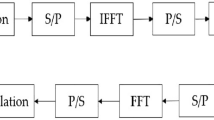Abstract
When radio signal propagates over the sea, the reflection of sea surface and the scattering of sea waves result in multipath components of the transmitted signal at the receiver. This paper introduces an analytical approach for developing multipath channel model for maritime wireless communications over sea. The presented modeling approach can establish the channel impulse response consisting of specular multipath and diffuse multipath produced by smooth sea surface and rough sea surface, respectively. Specifically, the diffuse multipath is obtained by accumulating diffuse scattering energy from the glistening surface. The methods for deriving specular multipath and diffuse multipath are given in detail. Finally, the numerical results of multipath channel models under different transmission conditions are obtained and analyzed using the introduced channel modeling approach.










Similar content being viewed by others
References
Rappaport, T. S. (2002). Wireless communications: Principles and practice. Upper Saddle River: Prentice Hall.
Maliatsos, K. N., Loulis, P., & Chronopoulos, M. (2006). Measurements and wideband channel characterization for over-the-sea propagation. In Proceedings of IEEE international conference on wireless and mobile computing, networking and communications (WiMob’06), (pp. 237–244)
Maliatsos, K. N., Loulis, P., & Chronopoulos, M. (2006). The power delay profile of the mobile channel for above the sea propagation. In Proceedings of IEEE international conference on vehicular technology conference (IEEE VTC’06 Fall), (pp. 1–5).
Reyes-Guerrero, J. C., & Mariscal, L. A. (2012). Experimental time dispersion parameters of wireless channels over sea at 5.8 GHz. In Proceedings of IEEE international symposium on ELMAR, (pp. 89–92).
Yang, K., Roste, T., & Bekkadal, F. (2012). Experimental multipath delay profile of mobile radio channels over sea at 2 GHz. In Antennas and propagation conference (LAPC), Loughborough, (pp. 1–4).
Haspert, K., & Tuley, M. (2011). Comparison of predicted and measured multipath impulse responses. IEEE Transaction on Aerospace and Electronic Systems, 47(3), 1696–1709.
Dong, M., Zhao, Y. B., & Zhang, S. H. (2009). The analysis of the multipath model under the VHF band and at sea. Acta Electronic Sinica, 36(6), 1373–1377.
Hu, X. Q., Chen, J. B., & Wang, Y. L. (2008). Research on metre-wave radar height-finding multipath model. Chinese Journal of Radio Science, 23(4), 651–657.
Ament, W. S. (1953). Toward a theory of reflection by a rough surface. Proceedings of the IRE, 41, 142–146.
Miller, A. R., Brown, R. M., & Vegh, E. (1984). New derivation for the rough-surface reflection coefficient and for the distribution of sea-wave elevation. Proceedings of the IEEE International Conference on Microwaves, Optics and Antennas, 131(2), 114–116.
Beard, C. I. (1961). Coherent and incoherent scattering of microwaves from the ocean. IRE Transactions on Antennas and Propagation, AP–9, 470–483.
Smith, B. (1967). Geometrical shadowing of a random rough surface. IEEE Transactions on Antennas and Propagation, 15(5), 668–671.
Kerr, D. E. (1951). Propagation of short radio waves. New York: McGraw-Hill.
Barrick, D. (1968). Rough surface scattering based on the specular point theory. International Journal of Antennas and Propagation, 16(4), 449–454.
Freyens, B. P, & Loney, M. (2011). Opportunities for white space usage in Australia. In IEEE wireless VITAE, (pp. 1–5).
Fitch, M., Nekovee, M., Kawade, S., Briggs, K., & MacKenzie, R. (2011). Wireless service provision in TV white space with cognitive radio technology: A telecom operator’s perspective and experience. IEEE Communications Magazine, 49(3), 64–73.
Acknowledgments
This paper was supported by the National Natural Science Foundation of China (Grant Nos. 61261024 and 61561017) and the Special Social Service Project Fund of Hainan University, China (Grant No. HDSF201301).
Author information
Authors and Affiliations
Corresponding author
Rights and permissions
About this article
Cite this article
Huang, F., Liao, X. & Bai, Y. Multipath Channel Model for Radio Propagation over Sea Surface. Wireless Pers Commun 90, 245–257 (2016). https://doi.org/10.1007/s11277-016-3343-4
Published:
Issue Date:
DOI: https://doi.org/10.1007/s11277-016-3343-4




